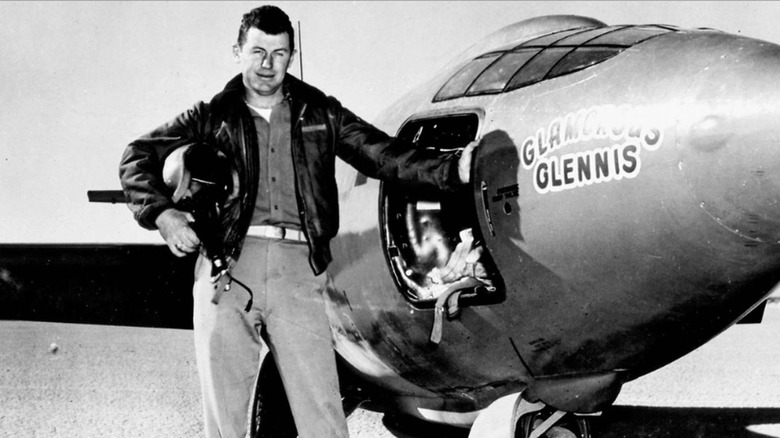How Chuck Yeager Broke The Sound Barrier In 1947
Back in 1947, there were a lot of firsts: The average (median) income was $3,000, the Polaroid Corporation introduced its very first instant-developing camera, an unidentified flying object crashed in Roswell, New Mexico, and Jackie Robinson became the first African-American to play professional baseball. It was in 1947 when man broke the sound barrier for the first time, as well.
The XS-1 (later shortened to X-1) rocket-powered supersonic research airplane started life in 1944 under a joint project between the National Advisory Committee for Aeronautics (NACA) — predecessor to NASA — and the U.S. Army Air Forces, which would become the U.S. Air Force in 1947.
In March 1945, Bell Aircraft Corporation was awarded the contract to get a plane through the transonic zone, the gap between subsonic and supersonic speeds. In other words, they needed to know if a manned aircraft could break through the "sound barrier" and live to tell the tale.
When Chuck Yeager first enlisted, he wasn't interested in planes or becoming a flyboy — he just wanted to be a mechanic. Yeager became a storied fighter pilot, with 13 confirmed victories over 64 missions, including one sortie in which he shot down five enemy aircraft to become an "ace-in-a-day."
He even shot down a jet-powered German Messerschmitt from his old propeller-powered P-51 Mustang. Moreover, he was shot down over occupied France in 1944, yet managed to evade capture by the Germans.
In 1945, he became a maintenance officer at Wright Field in Ohio, where his test-piloting career took off. He transferred to Muroc Air Base (now Edwards Air Force Base) in California in July 1947, and was soon assigned to test the XS-1.
Spread your razor thin wings and fly
Bell built three XS-1 test planes for the project. The 30 feet nine inches long, cylindrical fuselage was made of high-strength aluminum, and was shaped like a .50 caliber bullet because it was stable at supersonic speeds. It had a wingspan of 28 feet and was 10 feet 8.5 inches high, but the wings and tail were razor-thin to compensate for extreme aerodynamic forces. A barely moveable horizontal stabilizer allowed Yeager to control it ever so slightly.
Stuffed inside the relatively small plane were two propellant tanks made from steel, twelve nitrogen spheres (needed for fuel and cabin pressurization), a pressurized cockpit for Yeager, three pressure regulators, the retractable landing gear, a wing carry-through structure, a four-chambered 6,000-pound-thrust rocket engine, and over 500 pounds of special equipment needed to gather the all-important data of blasting through the invisible sound "barrier."
Before Yeager made his historic flight, the XS-1 was put through its paces, making "dozens of preparatory flights," all of which were dropped in-flight from either a Boeing B-29 or B-50 Superfortress aircraft. Its first glide test happened in early 1946 at Pinecastle Field in Florida, while the first powered test happened at Muroc in December 1946 — with Bell test pilot Chalmers Goodlin behind the stick.
Then, on October 14, 1947, with Captain Chuck Yeager in the cockpit of the christened "Glamorous Glennis" (named in honor of his wife) — he was dropped from a B-29 at 20,000 feet. Yeager took off, climbed to an altitude of 42,000 feet, and shot into history, reaching a speed of 700 miles per hour (Mach 1.06).
